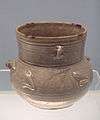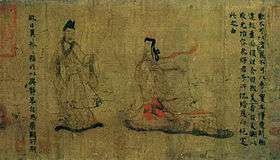Jin dynasty (265–420)
The Jin dynasty, distinguished as the Sima Jin and Liang Jin, was a Chinese dynasty, empire, and era traditionally dated from AD 265 to 420. It was founded by Sima Yan, son of Sima Zhao who was created Prince of Jin and posthumously declared the founder of the dynasty. It followed the Three Kingdoms period (220-280 AD), which ended with the conquest of Eastern Wu by the Jin.
There are two main divisions in the history of the dynasty: the Western Jin (265–316) when the capital was located at Luoyang or Chang'an (modern Xi'an) and the Eastern Jin (317–420) when it was relocated to Jiankang (modern Nanjing). Sima Rui was forced to relocated to Jiankang owing to civil wars and invasion from the Five Barbarians of the north and west. The Eastern Jin was eventually overthrown by the Liu Song.
History

Under the Wei, who dominated China's Three Kingdoms period, the Sima clan rose to prominence, particularly after the 249 coup d'état at the Gaoping Tombs. Sima Zhao assisted the throne in suppressing other rebellions, recovering Shu and capturing Liu Shan in 263 and opposing Zhong Hui's rebellion the next year. His ambitions for the throne remain proverbial in Chinese but he died before he could rise higher than prince of Jin, a title named for the Zhou-era marchland and duchy around Shaanxi's Jin River. (He was granted the title as his ancestral home was located in Wen County within Jin's former lands.)
The Jin dynasty was founded in AD 265 by Sima Yan, posthumously known as Emperor Wu (the "Martial Emperor of Jin"). He forced Cao Huan's abdication but permitted him to live in honor as the prince of Chenliu and buried him with imperial ceremony. There was a brief period of Chinese unity following the conquest of Eastern Wu in 280, but the state was soon weakened by corruption, political turmoil, and internal conflicts. Sima Yan's son Zhong, posthumously known as Emperor Hui (the "Benevolent Emperor of Jin"), was developmentally disabled. Conflict over his succession in 290 expanded into the devastating War of the Eight Princes. Afterwards, the empire was too weak to resist the uprisings and invasions of the Wu Hu (the "Five Barbarians"). Large numbers of Chinese fled south from the Central Plains; among other effects, these refugees and colonizers gave Quanzhou's Jin River its name as they settled its valley in Fujian. The Jin capital Luoyang was captured by Liu Cong in 311. Sima Chi, posthumously known as Emperor Huai (the "Missing Emperor of Jin"), was captured and later executed. His successor Sima Ye, posthumously known as Emperor Min (the "Suffering Emperor of Jin"), was captured at Chang'an (present-day Xi'an) in 316 and also later executed.[2]
The remnants of the Jin court fled to the east, reestablishing their government at Jiankang within present-day Nanjing, Jiangsu. Sima Rui, the prince of Langye, was enthroned in 318, posthumously becoming known as Emperor Yuan (the "First Emperor of the Eastern Jin").[2] The rival northern states, who denied the legitimacy of his succession, sometimes referred to his state as "Langye". The Emperors of Eastern Jin had limited power, owing to their dependence on the support of both local and refugee noble families (notably the Huan, Wang, and Xie) which possessed military power. Although there was a stated goal of recovering the "lost northern lands", paranoia within the royal family and a constant string of disruptions to the throne caused the loss of support among many officials. Military crises—including the rebellions of the generals Wang Dun and Su Jun but also lesser fangzhen (方鎮, "military county") revolts—plagued the Eastern Jin throughout its 104 years of existence.
Special "commanderies of immigrants" and "white registers" were created for the massive amount of northern origin Han Chinese who moved south during the Eastern Jin dynasty.[3] The southern Chinese aristocracy was formed from the offspring these migrants.[4] Celestial Masters and the nobility of northern China subdued the nobility of southern China during the Eastern Jin and Western Jin in Jiangnan in particular.[5] The most populous region of China was southern China after the depopulation of the north and the migration of northern Chinese to southern China.[6][7] Different waves of migration of aristocratic Chinese from northern China to the south at different times resulted in distinct groups of lineages, with some lineages arriving in the 300s-400s and others in the 800s-900s.[8]
The Eastern Jin recovered its unity in the face of the 383 invasion by the Former Qin. The short-lived coöperation among Huan Chong (brother of General Huan Wen) and Prime Minister Xie An helped provide a major victory at the Fei River. A large amount of Former Qin territory was then taken or retaken. Later, Huan Xuan, Huan Wen's son, usurped the throne and changed the dynasty's name to Chu. He, in turn, was toppled by Liu Yu, who reinstated Sima Dezong, posthumously known as Emperor An (the "Peaceful Emperor of Jin"). Meanwhile, as civilian administration suffered, there were further revolts led by Sun En and Lu Xun; Western Shu became an independent kingdom under Qiao Zong. Liu Yu had Sima Dezong strangled and replaced by his brother Sima Dewen, posthumously known as Emperor Gong (the "Respectful Emperor of Jin"), in 419. Sima Dewen abdicated in 420 in favor of Liu Yu, who declared himself the ruler of the Song; he was asphyxiated with a blanket the following year. In the north, Northern Liang, the last of the Sixteen Kingdoms, was conquered by the Northern Wei in 439, ushering in the Northern dynasties period.
The Xianbei Northern Wei accepted the Jin refugees Sima Fei (司馬朏) and Sima Chuzhi (司馬楚之). They both married Xianbei princesses. Sima Fei's wife was named Huayang (華陽公主), who was the daughter of Emperor Xiaowen; Sima Chuzhi's son was Sima Jinlong (司馬金龍), who married a Northern Liang princess who was a daughter of Xiongnu King Juqu Mujian.[9] Much later, Sima Guang (1019–1086), who served as prime minister to the Song, claimed descent from the Jin dynasty.
Culture
The Jin dynasty is well known for the quality of its greenish celadon porcelain wares, which immediately followed the development of proto-celadon. Jar designs often incorporated animal, as well as Buddhist, figures.[10]
Examples of Yue ware are also known from the Jin dynasty.[11]

 Celadon lian bowl with Buddhist figures, Western Jin, 265–317 CE.
Celadon lian bowl with Buddhist figures, Western Jin, 265–317 CE. Celadon jar, Eastern Jin, 317–420 CE.
Celadon jar, Eastern Jin, 317–420 CE. Celadon jar with brown spots, Eastern Jin, 317-420 CE.
Celadon jar with brown spots, Eastern Jin, 317-420 CE. 'Palace Lady' detail from 'Admonitions of the Instructress to the Palace Ladies' (女史箴图), 344 - 405 AD
'Palace Lady' detail from 'Admonitions of the Instructress to the Palace Ladies' (女史箴图), 344 - 405 AD
List of emperors
 | |||||||
|---|---|---|---|---|---|---|---|
| ANCIENT | |||||||
| Neolithic c. 8500 – c. 2070 BC | |||||||
| Xia dynasty c. 2070 – c. 1600 BC | |||||||
| Shang dynasty c. 1600 – c. 1046 BC | |||||||
| Zhou dynasty c. 1046 – 256 BC | |||||||
| Western Zhou | |||||||
| Eastern Zhou | |||||||
| Spring and Autumn | |||||||
| Warring States | |||||||
| IMPERIAL | |||||||
| Qin dynasty 221–206 BC | |||||||
| Han dynasty 206 BC – 220 AD | |||||||
| Western Han | |||||||
| Xin dynasty | |||||||
| Eastern Han | |||||||
| Three Kingdoms 220–280 | |||||||
| Wei, Shu and Wu | |||||||
| Jin dynasty 265–420 | |||||||
| Western Jin | |||||||
| Eastern Jin | Sixteen Kingdoms | ||||||
| Northern and Southern dynasties 420–589 | |||||||
| Sui dynasty 581–618 | |||||||
| Tang dynasty 618–907 | |||||||
| (Second Zhou dynasty 690–705) | |||||||
| Five Dynasties and Ten Kingdoms 907–960 |
Liao dynasty 907–1125 | ||||||
| Song dynasty 960–1279 |
|||||||
| Northern Song | Western Xia | ||||||
| Southern Song | Jin | ||||||
| Yuan dynasty 1271–1368 | |||||||
| Ming dynasty 1368–1644 | |||||||
| Qing dynasty 1644–1911 | |||||||
| MODERN | |||||||
| Republic of China 1912–1949 | |||||||
| People's Republic of China 1949–present |
Republic of China (Taiwan) 1949–present | ||||||
| Posthumous names | Family name and given names | Durations of reigns | Era names and their according range of years |
|---|---|---|---|
| Chinese convention: "Jin" + posthumous name + "di" | |||
| Western Jin dynasty 265–316 | |||
| Wu Di | Sima Yan | 266–290 |
|
| Hui Di | Sima Zhong | 290–307 |
|
| none | Sima Lun | 301 |
|
| Huai Di | Sima Chi | 307–311 |
|
| Min Di | Sima Ye | 313–316 |
|
| Eastern Jin dynasty 317–420 | |||
| Yuan Di | Sima Rui | 317–323 |
|
| Ming Di | Sima Shao | 323–325 |
|
| Cheng Di | Sima Yan | 325–342 |
|
| Kang Di | Sima Yue | 342–344 |
|
| Mu Di | Sima Dan | 344–361 |
|
| Ai Di | Sima Pi | 361–365 |
|
| Fei Di | Sima Yi | 365–372 |
|
| Jianwen Di | Sima Yu | 372 |
|
| Xiaowu Di | Sima Yao | 372–396 |
|
| An Di | Sima Dezong | 396–419 |
|
| Gong Di | Sima Dewen | 419–420 |
|
Major events
See also
- Chinese sovereign
- Ge Hong
- List of tributaries of Imperial China
- Liu Song dynasty
- Northern dynasties
- Northern Wei dynasty
- Romance of the Three Kingdoms
- Six Dynasties
- Sixteen Kingdoms
- Southern dynasties
References
Citations
- 1 2 Taagepera, Rein (1979). "Size and Duration of Empires: Growth-Decline Curves, 600 B.C. to 600 A.D.". Social Science History. 3 (3/4): 128. doi:10.2307/1170959. Retrieved 16 September 2016.
- 1 2 Grousset, Rene (1970). The Empire of the Steppes. Rutgers University Press. pp. 56–57. ISBN 0-8135-1304-9.
- ↑ Gernet (1996), p. 182.
- ↑ Nicolas Olivier Tackett, The Transformation Of Medieval Chinese Elites (850-1000 C.E.) p. 81.
- ↑ John Lagerwey; Pengzhi Lü (30 October 2009). Early Chinese Religion: The Period of Division (220-589 Ad). BRILL. pp. 831–. ISBN 90-04-17585-7.
- ↑ Historical Atlas of the Classical World, 500 BC--AD 600. Barnes & Noble Books. 2000. p. 2.25. ISBN 978-0-7607-1973-2.
- ↑ Haywood, John; Jotischky, Andrew; McGlynn, Sean (1998). Historical Atlas of the Medieval World, AD 600-1492. Barnes & Noble. p. 3.21. ISBN 978-0-7607-1976-3.
- ↑ Hugh R. Clark (2007). Portrait of a Community: Society, Culture, and the Structures of Kinship in the Mulan River Valley (Fujian) from the Late Tang Through the Song. Chinese University Press. pp. 37–38. ISBN 978-962-996-227-2.
- ↑ China: Dawn of a Golden Age, 200-750 AD, Metropolitan Museum of Art, 2004, pp. 18 ff., ISBN 978-1-58839-126-1
- ↑ Shanghai Museum permanent exhibit
- ↑ Guimet Museum permanent exhibit
Sources
- Gernet, Jacques (1996). A History of Chinese Civilization. Cambridge University Press. ISBN 978-0-521-49781-7.
External links
| Wikimedia Commons has media related to Jin dynasty (265-420). |
- Chinese History, the Jin Dynasty 晉
- Largest Jin Dynasty Tomb Discovered in NW China
- Early Imperial China: A Working Collection of Resources
- History of China: A good catalogue of info
- de Crespigny, Rafe. "HE THREE KINGDOMS AND WESTERN JIN A HISTORY OF CHINA IN THE THIRD CENTURY AD" (PDF). Retrieved 11 July 2016.
| Preceded by Three Kingdoms |
Dynasties in Chinese history 265–420 |
Succeeded by Northern and Southern dynasties |



